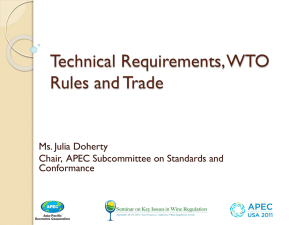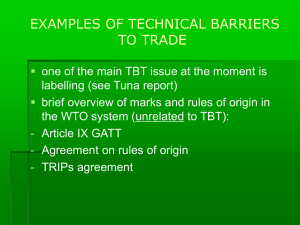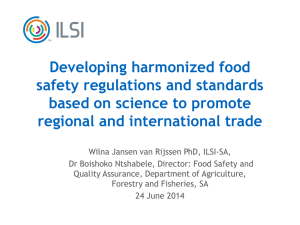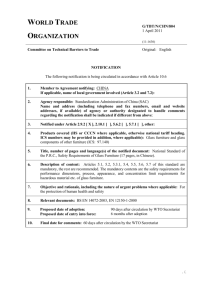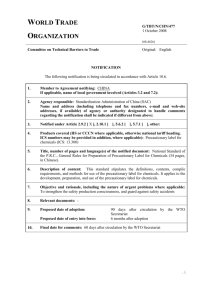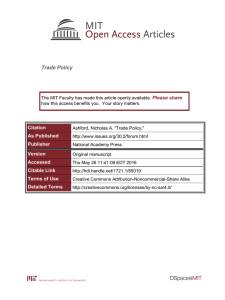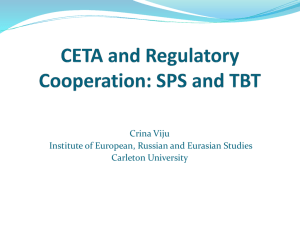Standards and Conformity Assessment Systems
advertisement
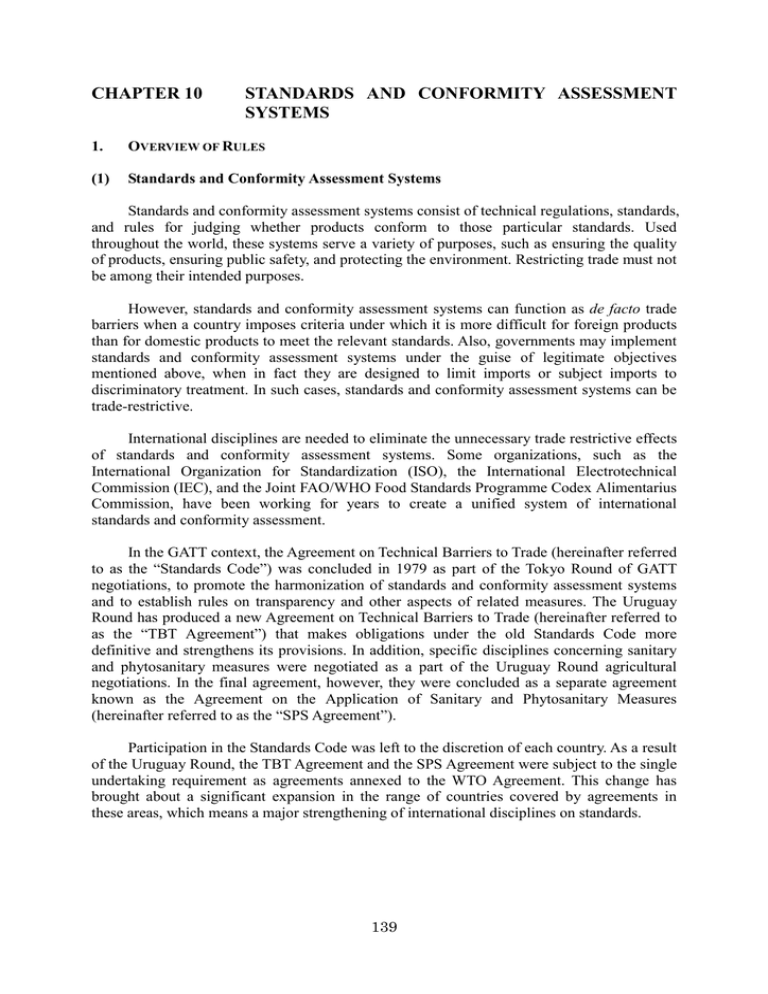
CHAPTER 10 STANDARDS AND CONFORMITY ASSESSMENT SYSTEMS 1. OVERVIEW OF RULES (1) Standards and Conformity Assessment Systems Standards and conformity assessment systems consist of technical regulations, standards, and rules for judging whether products conform to those particular standards. Used throughout the world, these systems serve a variety of purposes, such as ensuring the quality of products, ensuring public safety, and protecting the environment. Restricting trade must not be among their intended purposes. However, standards and conformity assessment systems can function as de facto trade barriers when a country imposes criteria under which it is more difficult for foreign products than for domestic products to meet the relevant standards. Also, governments may implement standards and conformity assessment systems under the guise of legitimate objectives mentioned above, when in fact they are designed to limit imports or subject imports to discriminatory treatment. In such cases, standards and conformity assessment systems can be trade-restrictive. International disciplines are needed to eliminate the unnecessary trade restrictive effects of standards and conformity assessment systems. Some organizations, such as the International Organization for Standardization (ISO), the International Electrotechnical Commission (IEC), and the Joint FAO/WHO Food Standards Programme Codex Alimentarius Commission, have been working for years to create a unified system of international standards and conformity assessment. In the GATT context, the Agreement on Technical Barriers to Trade (hereinafter referred to as the “Standards Code”) was concluded in 1979 as part of the Tokyo Round of GATT negotiations, to promote the harmonization of standards and conformity assessment systems and to establish rules on transparency and other aspects of related measures. The Uruguay Round has produced a new Agreement on Technical Barriers to Trade (hereinafter referred to as the “TBT Agreement”) that makes obligations under the old Standards Code more definitive and strengthens its provisions. In addition, specific disciplines concerning sanitary and phytosanitary measures were negotiated as a part of the Uruguay Round agricultural negotiations. In the final agreement, however, they were concluded as a separate agreement known as the Agreement on the Application of Sanitary and Phytosanitary Measures (hereinafter referred to as the “SPS Agreement”). Participation in the Standards Code was left to the discretion of each country. As a result of the Uruguay Round, the TBT Agreement and the SPS Agreement were subject to the single undertaking requirement as agreements annexed to the WTO Agreement. This change has brought about a significant expansion in the range of countries covered by agreements in these areas, which means a major strengthening of international disciplines on standards. 139 (2) Legal Framework <TBT Agreement> The TBT Agreement sets forth certain requirements for technical regulations, standards, and conformity assessment procedures for products or related processes and production methods ( PPMs ). These terms are defined as follows: (i) Technical regulations: Technical specifications, including applicable administrative provisions, with which compliance is mandatory by law or regulation; (ii) Standards: Standards with which compliance is not mandatory; and (iii) Conformity assessment procedures: Procedures to judge whether a product conforms to applicable technical regulations and standards, and to accredit conformity assessment bodies. To ensure that such technical regulations, standards and conformity assessment procedures do not act as unnecessary barriers to trade, the TBT Agreement directs standardizing bodies to ensure most-favoured-nation treatment and national treatment, to use international standards as a basis for new technical regulations, and to use standards and conformity assessment procedures when preparing them. It also requires standardizing bodies to take appropriate steps to ensure transparency, such as notifying the WTO when preparing or revising standards. The TBT Agreement requires the following two kinds of obligations for Members with respect to their central and local government standardizing bodies and their non-governmental standardizing bodies. The first is the primary obligation for Members to ensure compliance by their own standardizing bodies with the TBT Agreement. The second is the related obligation for Members to take reasonable measures as may be available to them to ensure compliance by their own standardizing bodies with the TBT Agreement (see Figure 10-1). Under the TBT Agreement, Members have various obligations including those to ensure transparency in general and also to notify the WTO. Standards and conformity assessment systems that have the effect of unjustifiably discriminating between domestic and foreign products or limiting the quantity of imports may constitute violations of the national treatment provision Article III of the GATT, the general elimination of quantitative restrictions provision Article XI of the GATT or the non-discriminatory administration of quantitative restrictions provision Article XIII of the GATT, depending on their content. These measures may also violate several articles including Articles 2.1 and 2.2 of the TBT Agreement which stipulate that: (i) Members shall ensure that in respect of technical regulations, products imported from the territory of any Member shall be accorded treatment no less favourable than that accorded to like products of national origin and to like products originating in any other country; and (ii) Members shall ensure that technical regulations are not prepared, adopted or applied with a view to or with the effect of creating unnecessary obstacles to international trade. 140 < Figure 10-1 > Members' Obligations Level of Government To comply (primary obligation) Central government (i),(ii),and (iii) Local governments On the level directly below (i) and (iii) (obligation to notify central government WTO) (prefectural level) Other local governments and non-governmental bodies Reasonable measures to ensure the compliance of local government and nongovernmental bodies (secondary obligation) (ii) (i)and (iii) (obligation other than WTO notification) (i),(ii)and (iii) : Note: (i) Technical regulations, (ii): Standards, (iii): Conformity assessment procedures An underlined character ( ) indicates obligations expanded or strengthened by the TBT Agreement. All obligations under (iii) were expanded, while (i) was strengthened with respect to local governments positioned one level directly below the central government. < SPS Agreement > The SPS Agreement seeks to prevent the use of sanitary and phytosanitary measures as disguised trade restrictions, and to harmonize national sanitary and phytosanitary measures based on international standards. The basic points are as follows: - Members have the right to take sanitary and phytosanitary measures necessary for the protection of human, animal, or plant life or health, provided that such measures are not inconsistent with the provisions of the SPS Agreement (Article 2.1). - Members shall ensure that any sanitary and phytosanitary measure is applied only to the extent necessary to protect human, animal, or plant life or health, based on scientific principles (Article 2.2). - Members shall ensure that sanitary and phytosanitary measurers do not arbitrarily or unjustifiably discriminate between Members where identical or similar conditions prevail. Sanitary and phytosanitary measures shall not be applied in a manner which would constitute a disguised restriction on international trade (Article 2.3). - Members shall base their sanitary or phytosanitary measures on international standards, guidelines, or recommendations, where they exist, except as otherwise provided for in the SPS Agreement (Article 3.1). - Members may introduce or maintain sanitary or phytosanitary measures which result in a higher level of sanitary or phytosanitary protection than would be achieved by measures based on the relevant international standards, guidelines or recommendations, if there is a scientific justification (Article 3.3). 141 - In cases where relevant scientific evidence is insufficient, a Member may provisionally adopt sanitary or phytosanitary measures on the basis of available pertinent information, including that from the relevant international organizations as well as from sanitary or phytosanitary measures applied by other Members (Article 5.7). - Members shall notify changes in their sanitary or phytosanitary measures and shall provide information on their sanitary or phytosanitary measures to ensure transparency. Margin should be even the SPS Agreement also specifies procedures for consultations and dispute settlement (Articles 7 and 11). < Box-1 > Mutual Recognition Article 6.3 of the TBT Agreement provides that “Members are encouraged, at the request of other Members, to be willing to enter into negotiations for the conclusion of agreements for the mutual recognition of results of each other's conformity assessment procedures.” The TBT Agreement thus encourages the mutual recognition of results of each other's conformity assessment procedures, not that of standards themselves. Mutual recognition is a tool used by the EU to integrate standards and conformity assessment systems as part of the larger process of market integration in the EU. The results have been favourable enough that the EU has been actively pursuing mutual recognition with external countries, in which the EU accepts the result of the conformity assessment procedures by its trading partner's conformity assessment bodies as equivalent to its own result, in exchange for the trading partner accepting the result of the conformity assessment procedures by the EU’s conformity assessment bodies. Mutual recognition streamlines conformity assessment procedures and reduces costs, and therefore, improves market access. The EU has discussed mutual recognition agreements ( MRAs ) with Australia, New Zealand, the United States, Canada, Switzerland, Japan, and other countries. It has already agreed to sign MRAs for some areas with Australia and New Zealand (both in July 1996) and the United States and Canada (both in June 1997). In the Transatlantic Economic Partnership, the EU states that it will develop the sector of conformity assessment systems, particularly between the EU and the United States. Japan and the EU began talks in May 1995 and are currently studying electrical appliances, telecommunication equipment, good manufacturing practice ( GMP ) for pharmaceuticals, and good laboratory practice ( GLP ) for chemical products. Australia has also begun mutual recognition talks with the United States, Canada, Japan, and other countries. When the Japanese Prime Minister visited Korea in March 1999, the two countries agreed to begin exchanging information with related to eventual mutual recognition agreement as called for in "Agenda 21." 142 < Box-2 > The Relationship between Eco-Labelling Schemes and the TBT Agreement The WTO Committee on Trade and Environment ( CTE ) has considered the relationship between eco-labelling schemes and the TBT Agreement as an item associated with standards and conformity assessment. Eco-labelling schemes seek to contribute to expansion of the market for environmentally-sound products by affixing a label that informs consumers of the products' environmental merits. It is used in many developed countries including Japan. There is a conflict of opinion between developed countries who emphasize the usefulness of eco-labelling schemes for environmental conservation and its relative lack of trade-impairing effects, and developing countries who worry that such labels do impair trade. All countries, however, recognize the significance of ensuring transparency in the administration of eco-labelling schemes as well as the need for full consideration of this issue. If eco-labelling schemes are subject to the TBT Agreement which deals with labelling rules, then transparency in the administration of the eco-labelling scheme can be ensured through the application of the TBT Agreement. However, countries are divided on their interpretation of the Agreement with respect to its coverage, with some maintaining that it covers standards which focus on non-product-related processes and production methods ( PPMs ), and others that do not. A form of eco-labelling certification that has gained growing prominence in recent years is the life cycle approach, which examines positive and negative impacts of products on the environment from the design stage through final disposal. This approach considers the environmental-soundness of the product itself (its energy conservation, for example) and also that of its PPMs (what happens to waste liquids from the manufacturing process, does it use Chlorofluorocarbons. ( CFCs ), etc.). In the CTE, some countries have argued either that the TBT Agreement should be interpreted to cover eco-labelling schemes focusing on non-product-related PPMs, or that new rules should be created outside of the TBT Agreement that would allow eco-labelling schemes focusing on non-product-related PPMs. Others, however, are of the opinion that, in light of the basic GATT rule that like products be given no less favourable treatment, the creation of eco-labelling schemes focusing on non-product-related PPMs itself is impermissible. No conclusion has been reached on this issue. It will require continued and careful discussion. For eco-labelling schemes that focus on product characteristics or product-related PPMs, the CTE has confirmed that transparency must be maintained in accordance with the TBT Agreement. (On a related subject, see the discussion in Chapter 3 of the Relationship between the WTO Agreements and Trade Measures pursuant to Multilateral Environment Agreements ( MEAs ), another major subject discussed in the CTE.) (3) Notification to the WTO The WTO disciplines on standards and conformity assessment emphasize the improvement of transparency by requiring notification of measures. The TBT Agreement and the SPS Agreement both include an obligation to notify other Members through the Secretariat and to allow reasonable time for other Members to make comments when a relevant international standard does not exist and if new standards or conformity assessment systems may have a significant effect on the trade of other Members. The Committee on TBT 143 and the Committee on SPS, established under the TBT Agreement and the SPS Agreement, recommend that this period of time be 60 days. Under the Standards Code, there was much discussion on how to ensure prompt notification, enhancement of the notification system will continue to be an important issue under the WTO because the increase in participating countries is expected to increase the number of notifications made. As supplementary information in this regard, we outline the number of notifications made under the Standards Code and the TBT Agreement. Between 1980 and 1999 there was a total of 7,400 notifications, of which 725 were from Japan (see Figure 10-2). In 1998, only 149 out of the total of 648 notifications (23 percent) had provided comment periods in excess of the 60 days recommended, but in 1999 there was a slight improvement to 162 out of 669 (24 percent; see Figure 10-3). < Figure 10-2 > Number of Notifications Country Under Standards Code * 1980-1994 Australia 1992 Canada 1980 EU 1980 Japan 1980 United States 1980 Total (including others) 54 396 226 548 500 4,464 Under TBT Agreement 1995-1998 1999 SubTotal 67 21 88 85 24 109 135 35 170 147 30 177 124 45 169 2,267 669 2,936 Total 142 505 396 725 669 7,400 (Source: GATT/WTO Documents) Note: * Year of participation in the Standards Code < Figure 10-3 > Length of Comment Period 1998 Less than 45 days Australia Canada EU Japan United States Total(incl.others) 7 15 8 8 8 241 45-59 days 0 0 14 3 10 151 1999 60 days or more 1 3 14 16 14 149 Not specified or lapsed 0 1 0 0 1 107 (Source: WTO Documents) Note: * including urgent notifications 144 Less than 45 days 4 8 1 9 13 243 45-59 days 11 11 1 15 6 166 60 days or more 4 5 32 6 25 162 Not specified or lapsed 2 0 1 0 1 98 (4) Economic Implications When significant differences exist between the standards and conformity assessment systems of different countries, the smooth development of free trade is likely to be impeded because exporters must deal with separate measures for each country, causing manufacturing and sales costs to increase. Furthermore, when such measures have an effect which discriminates between domestic and foreign products, or limits the quantity of imports, international trade is unreasonably distorted. To enhance free trade, it is essential to promote the international harmonization of standards and conformity assessment systems, to provide more transparency in the drafting and administration processes of domestic standards regulations, and to ensure that equal treatment is accorded to domestic and foreign products. Sanitary and phytosanitary measures are applied to prevent the entry of diseases and pests from abroad, taking into account their prevalence in exporting countries and importing countries, and other relevant factors, based on scientific and technical ground. Although there will naturally be differences in the sanitary and phytosanitary systems adopted by different countries, in no case should they be used to disguise restrictions on international trade. 145 < Box-3 > The TBT Agreement and inappropriate international standards The TBT Agreement obligates Members in principle to base their technical regulations (technical regulations established for purposes such as consumer safety and environmental conservation, which must be adhered to in order for products to be distributed) and standards (standards that are not mandatory, but are referred to in order to facilitate transactions) on internationally-accepted standards. The intention behind the Agreement is to have Members bring their national standards into line with international standards so as to reduce the barriers to trade caused when different countries employ different standards. In light of its TBT Agreement obligations, Japan worked from 1995 to 1997 to bring its national "JIS" standards in line with international standards formulated by the ISO and IEC. It found, however, that many international standards contained technology that was already obsolete or failed to accurately reflect market conditions so that it would be inappropriate to bring Japanese standards into conformance with them. (The field of pipe joints is one particularly vivid example.) The existence of such "inappropriate international standards" means that the TBT Agreement obligations, which were designed to lower the barriers to trade, work in the favour of only particular countries, regions, and industries, and actually inhibit appropriate competition. As a result, they have the potential to expand the barriers to trade rather than reduce them. There are two problems in the review process of "international standardization institutions" that undoubtedly contribute to the existence of "inappropriate international standards:" 1) Measures to ensure the openness and fairness of procedures and the transparency of the review process are insufficient, and therefore do not accurately reflect the wishes of national industries or consumers. 2) International standards have not been reviewed in an appropriate and timely manner, so that "inappropriate standards" remain on the books long after their usefulness has expired. International standardization institutions need to take steps to develop more appropriate standards so as to resolve these issues. At the same time, we also need to express our concerns over "inappropriate international standards" at WTO fora, and take steps to explain and discuss the nature of the problems involved. In 1997 Japan brought these problems up during the three-year review of the TBT Agreement. We are continuing to deepen the discussion in preparation for the next three-year review (scheduled to conclude during 2000), and look forward to appropriate remedies during the next round of liberalization negotiations. 146 < Box-4 > Genetically-engineered agricultural products In 1994, the United States began to commercialize genetically-engineered agricultural products (herbicide-resistant soybeans, pest-resistant corn, herbicide-resistant rape seed), and large-scale commercialization of these crops began shortly thereafter in the United States, Canada, Argentina, and other countries. By 1998, a total of 27.8 million hectares were under cultivation, approximately 75 percent of which were in the United States. When Argentina and Canada are factored in, the three countries had a combined total of 99 percent of world production. Estimates for 1998 show that in terms of land under cultivation approximately 30 percent of herbicide-resistant strains of US soybean, 20-30 percent of pest-resistant US corn, and approximately 40 percent of herbicide-resistant Canadian rape seed are used in genetically-engineered food products. The safety of genetically-engineered agricultural products is still being debated, as are appropriate labelling methods, and large gaps can be observed in the thinking and attitudes of different countries and regions. Disputes about Safety: In 1990, the EU began requiring importers and distributors to submit information on environmental impact and human risk, and review and approval procedures were formulated for EU members and the EU as a whole. Some EU members were dissatisfied with these regulations, however, prompting the EU to announce a moratorium on approvals for genetically-engineered agricultural products until such time as the absence of detrimental environmental and health effects could be demonstrated or desired improvements were implemented (Decision of Environmental Ministers Meeting, June 1999). The US has denounced this decision, which it calls scientifically unfounded and inspired by opposition from environmental groups and by political motives. Disputes about Labelling: In May 1997, the EU enacted new food regulations requiring labelling for products that are not equivalent to conventional products in composition, nutrients or use, that impact the health of specific individuals, that may generate ethical concerns, or that contain vegetables or other items. with genetically-altered cells. Currently no such products are distributed in the EU. Labelling is required for genetically-engineered agricultural products approved prior to the new food regulations if these products contain altered DNA or new proteins. (Regulations took effect in November 1997, with detailed rules formulated in May 1998.) The US does not require labelling of genetically-engineered agricultural products, except in cases where there are significant changes in composition compared to existing products, or where there are clear increases in allergic reactions or other health risks. The US has denounced the EU labelling regulations for genetically-engineered agricultural products, arguing that the detection methods and marginal detection values for DNA and new proteins are not established, and that segregated management of genetically-engineered and conventional agricultural products in the production and distribution stages will be excessively costly. Japan finalized its labelling rules for genetically modified foods on August 10, 1999. Products will be required to note the use of genetically modified foods in their quality labelling under the amended JAS Law. (The law is scheduled for promulgation in April 2000, followed by an appropriate transition period before it takes effect.) 147 Discussion in International fora: The Organization for Economic Cooperation and Development (OECD) has established a "Working Group on Harmonization of Biotechnology Regulation and Supervision" to study concepts for evaluating environmental and food safety and internationally harmonizing the environmental safety regulations of member countries. The Working Group is currently building a system for international institutions and members to exchange information on the scientific findings that underlie safety evaluations and current regulations on genetic engineering. The OECD has also established a "Task Force on New Food and Fertilizer Safety" to undertake a specific study of the safety of food and fertilizer products. This Task Force is engaged in efforts similar to those of the Working Group. The Cologne Summit of June 1999 called for a report on biotechnology and food safety to be prepared by July 2000. The Food Labelling Group of CODEX began studying the labelling of genetically modified foods in 1997, and in April 1999 decided to establish a working group of a small number of countries to study the issues in more detail. CODEX also established an ad hoc group to formulate international standards for evaluating the safety of biotechnology-applied foods in July 1999. The signatories to the Convention on Biological Diversity began in 1996 to study the formulation of a "Bio Safety Protocol" that would contain provisions for the safe transport, handling and use of living modified organism during export and import. This protocol was adopted in January 2000. At the WTO, the Committee on Technical Barriers to Trade (TBT Committee) is discussing the EU labelling regulations for genetically modified agricultural products. The US argues that the rules constitute a significant barrier to trade because application began before a list of exempted products was compiled. The EU argues that genetically modified agricultural products are scientifically different from conventional foods and that its consumers therefore have a strong need for labelling. 2. PROBLEMS OF TRADE POLICIES AND MEASURES IN INDIVIDUAL COUNTRIES Measures taken in connection with standards and conformity assessment systems and with sanitary and phytosanitary systems must be enacted and implemented to the minimum extent necessary for certain purposes, e.g., to ensure product quality, to maintain safety and health, to protect the environment. Japan should urge that measures that act as avoidable entry barriers against domestic markets be either abolished or simplified, and operated in a more transparent manner in light of the TBT Agreement and the SPS Agreement. Recently, countries are increasingly active in establishing and improving standards aimed at protecting the environment. It would be necessary to ensure their transparency, and to watch carefully in particular whether they respect relevant international standards, and whether they constitute unnecessary obstacle to international trade. If such measures discriminate against imports, either in general or from specific countries, or become unnecessary import restrictions, it is necessary to deal with them by urging their rescission, and by claiming their inconsistency with the WTO Agreement through the WTO dispute settlement mechanism where necessary. 148 (1) United States (i) American Automobile Labelling Act The American Automobile Labelling Act was enacted under Section 210 of the Passenger Motor Vehicle Content Information Disclosure Act of October 1992. It requires all passenger cars and light trucks to carry labels indicating their domestic content percentage of value added in the United States and Canada. More specifically, labels must indicate: - - The content percentage of United States and Canadian parts (on a model-bymodel basis). The country, state and city of final assembly. If countries other than the United States and Canada supply 15 percent or more of the parts in the vehicle, the label must indicate the top two countries supplying parts and the percentages supplied by each country. The country of origin of the engine and transmission (the country adding 50 percent or more of the value or the most added-value). The Act took effect on 1 October 1994. Violations are subject to a fine of $1,000 per vehicle. The explanation offered for the system is that it will help consumers make better purchasing decisions by providing them with information on the percentage of the automobile's price produced within the United States/Canada. But the system is in fact a “Buy American” provision that implicitly attempts to call on consumers to buy domestic goods. We find that the following aspects of the law discriminate against foreign automobiles: - It distinguishes between parts purchased from wholly-owned subsidiaries and independent suppliers, and uses different methods to calculate their value. Parts from wholly-owned subsidiaries can be counted at full purchase price even if their local content is less than 70 percent, while parts from foreign independent suppliers are not allowed to count as domestic parts at all unless their US/Canadian content is in excess of 70 percent. - Calculations are based on model averages. Thus, if the same model is produced both inside the United States and in other countries, a weighted average of the two is applied. As a result, the content of cars produced by foreign automotive makers within the United States is understated, because foreign automotive makers typically have factories in other countries besides the United States and Canada. - Content is calculated at the place of final assembly, but the rules specify that the place of final assembly be geographically separate from the location of the painting process. Foreign automotive makers, who generally utilize integrated production systems in which painting is done at the final assembly factory, are not able to count painting costs in the purchase price, so their contents are calculated less favourably than American auto makers’ content. - Content is calculated only in terms of parts prices, excluding the labour and assembly costs incurred for final assembly of the vehicle. If the purpose of the even margin law is to measure the value added in the United States and Canada, 149 then labour costs should obviously be included. Failure to do so results in an unnecessary understatement of US/Canadian value. - US/Canadian content is handled together and a breakdown of their respective portions is not published. This is problematic in terms of Most-Favoured-Nation Treatment because it disadvantages countries other than Canada. Additionally, the law forces foreign auto makers with operations in the United States, who tend to use large amounts of non-US/non-Canadian parts, and dealers, who import vehicles, to take on an enormous amount of clerical work and record-keeping in order to calculate parts percentages. The system is therefore likely to become an unnecessary obstacle to trade and may be in violation of Article 2.1 and 2.2 of the TBT Agreement. Although the full effects of this system on trade are not obvious, Japan should monitor developments under the law and when necessary use bilateral consultations and other means to resolve any problems. (ii) Regulation on Corporate Average Fuel Economy (CAFE) The Energy Policy and Conservation Act of 1975 includes Corporate Average Fuel Economy (CAFE) regulations obligates automobile manufacturers and importers to achieve certain levels of average fuel economy for the vehicles they handle, providing fines levied on violations. CAFE regulations stipulate that domestic and imported vehicles be distinguished and their average fuel economy be calculated separately. Because most of the vehicles exported by European manufacturers to the United States were large cars with low fuel economy, the EU considered the CAFE programme to be discriminating against such imported large cars. In May 1992, the EU requested consultations with the United States because it viewed the CAFE regulations as being inconsistent with Article III:4 of the GATT provisions for national treatment. In March 1993, it requested that a GATT panel be established because it did not receive a satisfactory response at the consultations. In September 1994, a report was issued.1 The panel noted that separate foreign fleet accounting prevented manufacturers of large domestic cars with low fuel economy from meeting the CAFE requirement for their domestic fleet by adding to it small foreign cars with high fuel economy. Such manufacturers may avoid fines only when they increase the volume of business of small domestic cars with high fuel economy. In such cases the CAFE measure placed small foreign cars in a less favourable competitive position with respect to small domestic cars. The panel also noted that the CAFE measure prevented manufacturers of large foreign cars with low fuel economy from meeting their CAFE requirements for their imported fleet by adding to it small domestic cars with high fuel economy. This treatment makes it difficult for large foreign car manufacturers to meet the CAFE requirements. In such cases the CAFE measure also placed large foreign cars in a less favourable competitive position with respect to large domestic cars. The panel therefore found the CAFE regulation in violated Article III:4 of the GATT because the requirement of separate foreign fleet accounting under the CAFE regulation accorded foreign products conditions of 1 During this panel, the EU also argued that (i) the “Luxury Tax” which was a retail excise tax imposed on cars sold for more than a certain price and the “Gas Guzzler Tax” imposed on the sale of each car that had low fuel economy also constituted a violation of GATT Article III:2. The panel, however, concluded that these measures did not violate GATT Article III:2. 150 competition less favourable than those accorded to like domestic products. It further found that the practice could not be justified under Article XX(g) of the GATT. The report was not adopted and the United States has taken the position that since the CAFE regulations do not harm EU commercial interests, there is no reason to revise them. (iii) Adoption of the metric system The purpose of the TBT Agreement is to reduce the technical barriers to international trade by encouraging the adoption of international standards. The ISO and other international standardization institutions have adopted the international system of units (SI), which is based on the metric system, as the units to be used in formulating standards. While virtually every other country in the world uses the SI--the metric system--the United States still uses yards and pounds for most purposes. Indeed, it is the only country not to have made any progress in adopting the metric system. This has enormous impact on world trade. In bilateral talks on structural issues and other bilateral conferences, Japan has sought measures from the United States to adopt the metric system. In the Second Annual Report of Structural Impediments Initiative Follow-up the U.S. committed: 1) to use the metric system in federal procurement, subsidy programs, and commercial activities, and 2) to implement a Department of Commerce study on ways to substantially expand and increase use of the metric system by the private sector. Similarly, in the second Joint Status Report on Japan-U.S. Enhanced Initiative on Deregulation and Competition Policy of 1999, the US committed to: 1) amending the Fair Packaging and Labelling Act to allow only metric indications for products designated by federal and state governments, and 2) to amend the uniform rules on packaging and labelling (formulated by the National Conference on Metrology). In spite of these commitments, only about 20 percent of private-sector businesses within the US use the metric system, and there has been no significant progress on its adoption. Japan continues to seek effective, on-going initiatives from the United States towards wider adoption of the metric system. (2) European Union Phytosanitary Measures The EU allows the import of Japanese five-leaf white pine, Japanese cypress and juniper bonsai plants from Japan, on the condition that they undergo inspections over a period of two years in Japan at the cultivation site and other phytosanitary measures. Plants meeting this condition, however, can only be imported for a period of three years. If Japan does not ask for an extension of the import period, the EU refuses to permit imports after the three-year deadline. The three-year limit on imports is not based on any scientific rationale. Japan should continue to request the EU to relieve this measure. 151 < Box-5 > Measures Concerning Meat and Meat Products (Hormones) In December 1985, the EU, referring to consumer concerns, decided that beginning in January 1988, all imports of meat from animal raised using hormones would be banned (the decision not to use hormones within the region was made in March 1988). The United States requested consultations under Article XXIII of the GATT arguing that the measures lacked scientific evidence and were inconsistent with Article 7.2 of the Tokyo Round Standards Code. In January 1989, the EU began enforcing a total ban on imports of meat raised with growth hormones. The United States, in response, invoked retaliatory measures that same month under Section 301 trade remedy 100 percent hikes in tariffs on beef, tomato-based products, coffee, alcoholic beverages and pet food, worth about $90 million. The impasse remained unresolved, in June 1995, the United States charged that the EU measures lacked a scientific basis and were in violation of both the GATT and the SPS Agreement. The Unites States intended to refer the matter to the WTO dispute settlement procedures, if the dispute was not resolved by the end of 1995. In response, the EU convened a “Scientific Conference on the Use of Growth Promoters in Meat Production” for scientists and consumer groups. The conference’s report, which was published in January 1996, concluded that the data on the use of natural and artificial hormones and related compounds has shown no evidence of human health risk. The EU agriculture ministers, however, decided to continue the import ban regardless. In January 1996 the United States, therefore, requested consultations under Article XXII of the GATT, alleging that the EU measures were inconsistent with Articles III and XI of the GATT, and Articles 2, 3, and 5 of the SPS Agreement. In May 1996 a panel was established. In July 1996 Canada also requested consultations under Article XXII of the GATT and in October 1996 a different panel was set up. In August 1997, the panel report was issued. It found that the EU measures were based on neither international standards nor any risk assessment, and that arbitrary or unjustifiable distinctions in the level of protection result in discrimination or a disguised restriction on international trade. The panel therefore found the EU measures in violation of SPS Agreement Articles 3.1, 5.1 and 5.5. In September 1997, the EU appealed the panel finding to the Appellate Body. In January 1998, the Appellate Body submitted its report, finding that the EU measures were not to be regarded as discrimination or a disguised restriction on international trade and therefore not inconsistent with Article 5.5 of the SPS Agreement. On the other hand, it upheld the panel's findings that the EU measures were not based on sufficient assessment of risk, and therefore found the measures to be in violation of Article 5.1 of the SPS Agreement. The Appellate Body reversed the ruling of the panel and found that the burden of proof to establish a WTO redaction remains on the complaining country (in this case, the United States). When a country introduces or maintains sanitary or phytosanitary measures which result in a higher level of protection than would be achieved by relevant international standards. In February 1998, the Appellate Body report was adopted, and the DSB advised the EU to take appropriate measures in light of the Appellate Body report. 152 The EU had an obligation that it would follow the Appellate body decision and bring its measures into conformance to the WTO by May 1999. However, the EU failed to withdraw the import ban by the deadline, prompting the US and Canada on 14 May to seek approval from the WTO for temporary suspension of concessions on imports from the EU equivalent to $220 million and $70 million respectively. On 12 July, the WTO announced results of arbitration finding the economic damage to the US and Canada from the EU beef import ban to be worth $117 million and $11.3 million respectively. The DSB approved a suspension of concessions based on these findings. In accordance with WTO procedures, the US hiked tariff rates effective 29 July, Canada effective 1 August. < Box-6 > Ban on Use of Livestock Products with TSE Risk (EU) An EU decision in July 1997 (97/534/EC) has banned in the EU all use of substances originating from particular organs (such as brains, spinal cord, eyeballs.) of cattle, sheep, and goats, beginning in January 1998. It will also require non-member countries, which export food, pharmaceuticals, or cosmetics (including intermediates for any of these) to the EU, to provide a certificate issued by the government of the country of origin attesting that these banned substances are not used, beginning in January 1998. This measure was responding to the possibility that human spongiform encephalopathy is caused by the intake of substances from cows afflicted with BSE (Bovine Spongiform Encephalopathy), one strain of TSE (Transmissible Spongiform Encephalopathy). It seeks to prevent the distribution of products containing ingredients that might cause TSE. (It is regarded that BSE itself was caused by the use in feeds of sheep that suffered from scrapie, the strain of spongiform encephalopathy that afflicts sheep.) Afterwards, EU Committee made a proposal that Members be divided into four types on a basis of the TSE occurrence conditions and each measure be dependent on each type. However, the proposal could not be carried out because of opposition from Members. EU, therefore, postponed starting the measures until January 2000. Moreover, the measures were postponed again after July 2000 because new scientific information should be required more. (3) Korea Detailed Rules for the Control of Product Origin In July 1991, Korea established “Detailed Rules for the Control of Product Origin” (Customs Agency Notification) that require labels of product origin to be affixed to the smallest packaging unit of products, according to a revision of the International Trade Control Regulations in May 1991. These labels had to be: (a) written in Hangul (domestic language) or English characters; (b) displayed in a form and method that is easy for final purchasers to read; (c) placed in an easily recognizable location; and (d) made in a way that they can be permanently preserved. The rules initially covered 250 items at the 4 digits level under the harmonized tariff system. In application, the system places excessive burdens on trading companies and therefore constitutes a restriction on trade which is likely to be inconsistent with Article II:2 of the TBT Agreement. 153 The system was slightly improved in May and July 1993 when revisions to the law made it possible to label in Chinese characters and expanded the number of exceptions for which labelling on the package was permitted. Effective July 2000, stamps and labels will be permissible for cases in which the nature of the product makes permanent labelling difficult. On the other hand, the revisions also strengthened the requirements to confirm the origin of OEM products. Since that time, there have been gradual additions to the list of products covered under the regulation, which had reached 650 as of January 2000. There are, therefore, many problems that remain. Japan pointed out the problems involved in this system during the Trade Policy Review ( TPRM ) for Korea that was held at the WTO in September 1996. We will need to continue to seek improvements for those requirements that place excessive burdens on exporters. (4) Australia Measures Affecting Importation of Salmon In September 1983, Australia began requiring permits for the importation of fresh, chilled, and frozen salmon products under the Quarantine Law of 1908 and Quarantine Ordinance 86A of 1975. In October 1995 Canada requested consultations under Article 4.4 of the DSU, claiming that the measure violated Article 2 (basic rights and obligations), Article 3 (harmonization), and Article 5 (assessment of risk and determination of the appropriate level of sanitary or phytosanitary protection) of the SPS Agreement as well as Article XI and Article XIII of the GATT. A panel was established for the case in April 1997. The panel, which submitted its report on 12 June 1998, found violations of Article 5.1 and Article 2.2 because Australia failed to provide evidence to refute the claim that it did not apply risk-assessment-based phytosanitary measures to all salmon products. The report also found no rational relationship between the measures and a 1996 report issued by Australia on the effectiveness of the standard for heating Salmon which had been offered as scientific rationale for the measures. It further noted that Australia did not impose restrictions on the importation or domestic distribution of other fishing products also potentially infect with the diseases at issue, and therefore found the measure to be a discriminatory and disguised trade restriction. Both Australia and Canada were dissatisfied with the panel report on several points and appealed. The Appellate Body upheld the panel judgements except that it overturned the rule on heating standards for smoked salmon under a 1988 ordinance, claiming that this issue was beyond the panel's scope. The Appellate Body report and the amended panel report were adopted by the DSB meeting on 25 November 1998. In July 1999, Australia amended its quarantine for salmon products, but Canada, claiming that the new system is still not in line with the SPS Agreement, requested the establishment of a panel under Article 21:5 of the DSU as a preliminary step to sanctions. Australia responded by seeking the establishment of an arbitration panel under Article 22:6 of the DSU. On 18 February 2000, the panel under Article 21.5 of the DSU found that Australia violated Articles 5.1 and 2.2 of the SPS Agreement. Japan should continue to monitor the developments. 154
